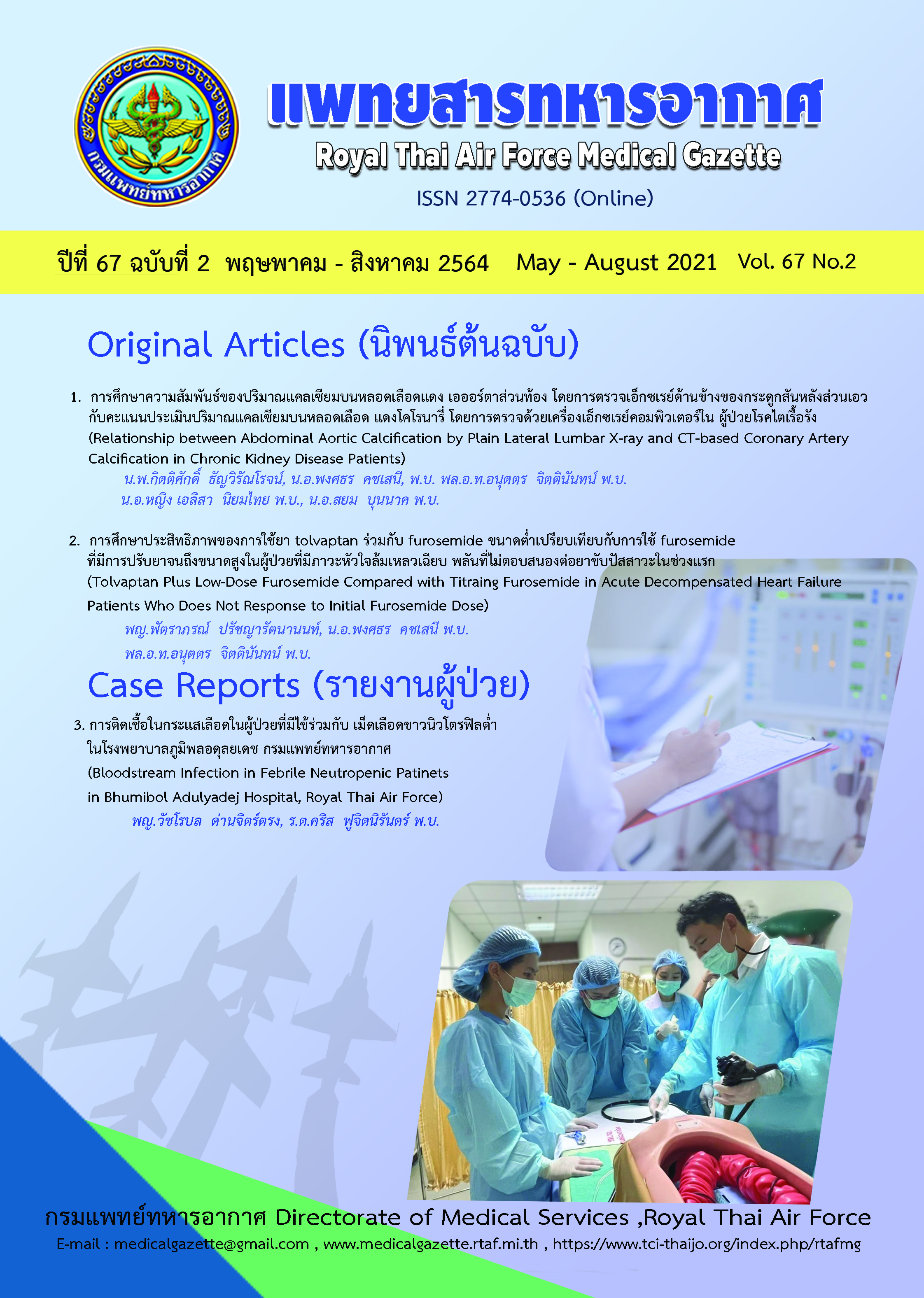Relationship between Abdominal Aortic Calcification by Plain Lateral Lumbar X-ray and CT-based Coronary Artery Calcification in Chronic Kidney Disease Patients
Main Article Content
Abstract
Background : The presence and severity of cardiovascular calcifications strongly predict cardiovascular mortality in patients with chronic kidney disease (CKD). Most studies examining calcification in CKD patients use computed tomographic (CT)-based techniques to detect coronary artery calcification (CAC); which is relatively expensive. This study focuses on testing whether lateral abdominal radiographs, which are widely available, less costly, could be used instead of CT imaging.
Methods : A cross-sectional study was done in pre-dialysis CKD patients in Bhumibol Adulyadej Hospital, Royal Thai Air Force. All participants were investigated by CT-based CAC scores and lateral plain film of the lumbosacral (LS) region to detect abdominal aortic calcification (AAC) scores within 3 months following enrolment. Medical data were collected from patients and medical records.
Results : A total of 70 patients (44 males, 26 females), aged 70.59+10.16 years were enrolled in this study. There was a significant association between CT-based CAC scores and plain film-based AAC scores. The correlation coefficient (r) between CAC scores and 4 scales AAC, 8 scales AAC and 24 scales AAC was 0.399 (p=0.001), 0.364 (p=0.002) and 0.385 (p=0.001), respectively. The CAC scores > 400, which is considered to be a good predictor of cardiovascular mortality, was chosen to be tested with various AAC scores. It was shown that CAC scores > 400 has strong correlation with AAC > 2 in 4 scales AAC (sensitivity = 93.5 %, specificity = 59 %, area under the curve (AUC) = 0.783), AAC > 3 in 8 scales AAC (sensitivity = 83.9 %, specificity = 64.1 %, AUC = 0.766), and
AAC > 4 in 24 scales AAC (sensitivity = 87.1 %, specificity = 71.8 %, AUC = .799). There was also a good correlation between each AAC scales.
Conclusion : Abdominal aortic calcification detected by lateral abdominal radiographs could be used instead of CT-based coronary calcification scores. Prognostic value of the abdominal aortic calcification in this population should be determined in large scale, prospective cohort studies.
Article Details

This work is licensed under a Creative Commons Attribution-NonCommercial-NoDerivatives 4.0 International License.
บทความที่ได้รับการตีพิมพฺเป็นลิขสิทธิ์ของวารสาร
References
Ingsathit A, Thakkinstian A, Chaiprasert A, Sangthawan P, Gojaseni P, Kiattisunthorn K, et al. Thai-SEEK Group.
Prevalence and risk factors of chronic kidney disease in the Thai adult population: Thai SEEK study. Nephrol Dial
Transplant. 2010;25(5):1567-75.
Shulman NB, Ford CE, Hall WD, Blaufox MD, Simon D, Langford HG, et al. Prognostic valve of serum creatinine
and effect of treatment of hypertension on renal function. Results from the hypertention detection and follow-up
program. The Hypertention Detection and Follow-up Program Cooperative Group. Hypertention 1989;13:180-93.
Foley RN, Parfrey PS, Sarnak MJ. Clinical epidemiology of cardiovascular disease in chronic renal disease. Am J
Kidney Dis 1998; 32:S112-9.
Weiner DE, Tighiouart H, Amin MG, Stark PC, MacLeod B, Griffith JL, et al. Chronic kidney disease as a risk
factor for cardiovascular disease and all-cause mortality: a pooled analysis of community-base studies. J Am Soc Nephrol
;15:1307-15.
Keith DS, Nichols GA, Gullion CM, Brown JB, Smith DH. Longitudinal follow-up and outcomes among a population
with chronic kidney disease in a large managed care organization. Arch Intern Med 2004;164: 659-63.
Keough-Ryan TM, Kiberd BA, Dipchand CS, Cox JL, Rose CL, Thompson KJ, et al. Outcomes of acute coronary
syndrome in a large Canadian cohort: impact of chronic renal insufficiency, cardiac interventions, and anemia.
Am J Kidney Dis 2005;46:845-55.
Russo D, Palmiero G, De Blasio AP, Balletta MM, Andreucci VE. Coronary artery calcification in patients with CRF
not undergoing dialysis. Am J Kidney Dis 2004;44:1024-30.
Ganesh SK, Stack AG, Levin NW, Hulbert-Shearon T, Port FK. Association of elevated serum PO(4), Ca x PO(4)
product, and parathyroid hormone with cardiac mortality risk in chronic hemodialysis patients. J Am Soc
Nephrol. 2001;12(10):2131-8.
Menon V, Greene T, Wang X, Pereira AA, Marcovina SM, Beck GJ, et al. C-reactive protein and albumin as
predictors of all-cause and cardiovascular mortality in chronic kidney disease. Kidney Int. 2005;68(2):766-72.
Raggi P, Boulay A, Chasan-Taber S, Amin N, Dillon M, Burke SK, et al. Cardiac calcification in adult hemodialysis
patients. A link between end-stage renal disease and cardiovascular disease. J Am Coll Cardiol 2002;39:695-701.
Mehrotra R, Budoff M, Christenson P, Ipp E, Takasu J, Gupta A, et al. Determinants of coronary artery calcification in diabetics
with and without nephropathy. Kidney Int 2004;66:2022-31.
Raggi P,Cooil B,Shaw L. Progression of coronary calcification on serial electron beam tomography scanning is greater in patients
with future myocardial infarction. Am J Cardiol;46:166-72.
Detrano R, Guerci AD, Carr JJ, Bild DE, Burke G, Folsom AR, et al. Coronary calcium as a predictor of coronary
events in four racial or ethnic groups. N Engl J Med. 2008;358(13):1336-45.
Tanenbaum S R,Kondos G T,Veselik K E. Detection of calcific deposits in coronary artery by ultrafast computed
tomography and correlation with angiography.Am J Cardiol;63:870-72.
Wilson PW, Kauppila LI, O’Donnell CJ, Kiel DP, Hannan M, Polak JM, et al. Abdominal aortic calcific deposits are
an important predictor of vascular morbidity and mortality. Circulation. 2001;103(11):1529-34.
KDIGO clinical practice guideline for the diagnosis, evaluation, prevention, and treatment of Chronic Kidney
Disease-Mineral and Bone Disorder (CKD-MBD).
Bellasi A, Ferramosca E, Muntner P, Ratti C, Wildman RP, Block GA, et al. Correlation of simple imaging tests and
coronary artery calcium measured by computed tomography in hemodialysis patients. Kidney Int. 2006; 70(9):1623-8.
Budoff MJ, Gul KM. Expert review on coronary calcium. Vasc Health Risk Manag. 2008;4(2):315-24.


